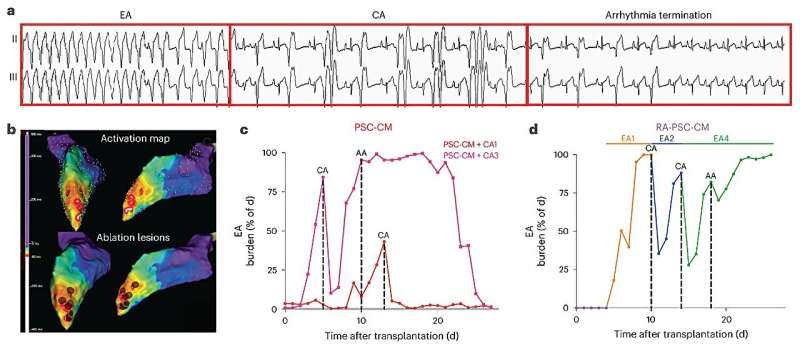This article has been reviewed according to Science X's editorial process and policies. Editors have highlighted the following attributes while ensuring the content's credibility:
fact-checked
proofread
Treating and preventing abnormal heart beats with stem cell muscle grafts

New research conducted at The Westmead Institute for Medical Research (WIMR) has solved a complication that could occur following an experimental procedure to repair damaged heart muscle. Currently, when a heart muscle is repaired with stem cells, there is a risk of developing an abnormal heartbeat. The research, conducted on animal models, has found a way to identify cells that are likely to have an abnormal beat, and that a combination therapy of existing drugs can control and potentially stop this abnormality.
In 2014, Professor James Chong led a research team at WIMR that used stem cells to successfully grow new heart muscle in animal models, to repair damage caused by heart attack.
Professor Chong, who is Co-Director of WIMR's Center for Cardiac Research, and a consultant interventional cardiologist at Westmead Hospital and Professor of Cardiovascular Medicine at the University of Sydney Faculty of Medicine and Health, explains there is currently no way to regenerate heart muscle that has been severely damaged or has died following a heart attack.
"At the moment, damaged or dead heart muscle cannot be replaced to any meaningful degree, so a heart transplant is the only 'cure' available to patients with end stage heart disease. However, not all patients are eligible for a transplant, and donor organs are in short supply. So, the potential to replace new, healthy heart muscle with a graft that has been created using stem cells could save many thousands of lives," says Chong.
The Australian Institute of Health and Welfare estimates that in 2021, cardiovascular disease was the underlying cause of 42,700 deaths (25% of all deaths) in Australia.
Solving a deadly complication
A potential complication has been identified in stem cell-derived heart muscle grafts—ventricular arrhythmias. Ventricular arrhythmias cause the heart to beat too fast, which prevents oxygen-rich blood from circulating to the brain and body and may result in cardiac arrest.
Professor Chong is lead author of new research now published in Nature Cardiovascular Research.
"We have identified factors that contribute to these ventricular arrythmias in animal models, as well as determining that existing clinical treatment strategies can control and potentially abolish these arrhythmias," says Professor Chong.
The research shows that the type of stem cells used, and the way they are developed into new heart muscle can be a cause of ventricular arrhythmia.
Professor Chong says, "We have detected specific cardiomyocytes (a type of heart muscle cell) that contribute to these ventricular arrhythmias, and we have been able to identify two unique surface marker signatures (SIRPA+/CD90-/CD200+ and SIRPA+/CD90-/CD200).
"This allows us to differentiate between arrhythmogenic and non-arrhythmogenic cardiomyocytes respectively, meaning we can choose the cells that are less likely to result in a deadly ventricular arrhythmia."
In terms of treating these ventricular arrhythmias, the research team has shown that a combination therapy of existing drugs can provide the required control.
Professor Chong explains, "When combined, amiodarone (a drug that works directly on heart tissue to slow the nerve impulses in the heart) and ivabradine (a drug used to treat heart failure by slowing the heart rate) were shown to significantly reduce the incidence of ventricular arrhythmia following this graft process."
Professor Chong says, with planning and recruitment for human clinical trials of stem-cell derived heart muscle grafts underway around the world, including at Westmead, there is an urgent unmet need to understand why these arrythmias occur, and to develop treatment strategies to control or prevent these engraftment arrhythmias.
"We are delighted that our research findings help to overcome a significant hurdle for the successful human application of stem cell-derived heart muscle grafts," says Professor Chong.
More information: Dinesh Selvakumar et al, Cellular heterogeneity of pluripotent stem cell-derived cardiomyocyte grafts is mechanistically linked to treatable arrhythmias, Nature Cardiovascular Research (2024). DOI: 10.1038/s44161-023-00419-3



















